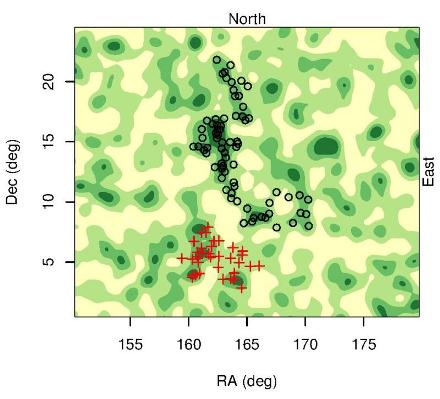|
The Well Balanced Universe |
|||
Astronomy newsBiggest structure in the universe challenges modern cosmology7 February 2013 An international team of astronomers, led by academics from the University of Central Lancashire, has found the largest known structure in the universe. This large quasar group (LQG) is some 4 billion years across and not predicted by modern theory. Quasars are the nuclei of galaxies undergoing 'brief' periods (10-100 million years) of extremely high brightness, making them visible from huge distances. Since 1982 it has been known that quasars tend to group together in clumps or structures of surprisingly large sizes, forming large quasar groups or LQGs. The team, led by Dr Roger Clowes, has identified the LQG which is so significant in size it challenges the Cosmological Principle: the assumption that the universe, when viewed at a sufficiently large scale, looks the same no matter where you are observing it from. The modern theory of cosmology, the standard big bang theory, is based on the work of Albert Einstein, and depends on the assumption of the Cosmological Principle. The Principle is assumed but has never been demonstrated observationally 'beyond reasonable doubt'.
To give some sense of scale, our galaxy, the Milky Way, is separated from its nearest neighbour, the Andromeda Galaxy, by about 0.75 Megaparsecs (Mpc) or 2.5 million light-years. Whole clusters of galaxies can be 2-3 Mpc across but LQGs can be 200 Mpc or more across. Based on the Cosmological Principle and the standard big bang theory, calculations suggest that astrophysicists should not be able to find a structure larger than 370 Mpc. Dr Clowes' newly discovered LQG however has a typical dimension of 500 Mpc and a longest dimension of 1200 Mpc (4 billion light years) — some 1600 times larger than the distance from the Milky Way to Andromeda. Dr Clowes said: "While it is difficult to fathom the scale of this LQG, we can say quite definitely it is the largest structure ever seen in the entire universe. This is hugely exciting — not least because it runs counter to our current understanding of the scale of the universe. This is significant not just because of its size but also because it challenges the Cosmological Principle, which has been widely accepted since Einstein. Our team has been looking at similar cases which add further weight to this challenge and we will be continuing to investigate these fascinating phenomena." Journal Reference:
Caption
|
|
||
More news ...
|
|||
